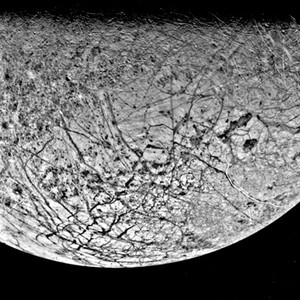The fourth-largest satellite of Jupiter and the second of the four Galilean satellites from the planet; also known as Jupiter II. Europa orbits in 3.551 days at a distance of 671 100 km. Its period of axial rotation is the same as its orbital period. Its diameter is 3122 km, making it only slightly smaller than our Moon. Europa’s density of 3.01 g/cm3 indicates that it is mainly composed of silicate rock, mixed with at least 5% water. It has a bright, icy surface of albedo 0.67, dominated by networks of dark, linear cracks, some over 1000 km long. Many of these are curved and are termed flexus; they are thought to arise from tidal stresses. Impact craters on Europa are few and far between, indicating that the surface is young and perhaps being resurfaced by icy flows. Jets of water vapour seen erupting from Europa suggest the presence of an ocean below the icy crust.
 http://photojournal.jpl.nasa.gov/catalog/PIA03002
http://photojournal.jpl.nasa.gov/catalog/PIA03002
The fourth-largest moon of the planet Jupiter, diameter 3 140 km, orbiting 671 000 km from the planet every 3.55 days. It is covered by ice and was originally thought to be criss-crossed by thousands of thin cracks some 50 000 km long. These are now known to be low ridges.
NASA's Galileo spacecraft began circling Europa in February 1997. One of the first discoveries from the data it sent back was that the ‘cracks’ covering the surface of the moon are in fact low ridges. These features lend credence to the idea that Europa possesses a hidden subsurface ocean. NASA planned to launch the Europa Orbiter in 2008 to arrive in 2010 and search for water beneath Europa’s icy surface, using a radar sounder and altimeter, but the project was cancelled in 2002.

The surface of Europa, here imaged by the Voyager 2 probe in 1979, is criss-crossed by a complex network of low ridges.
Credit: NASA
The smallest of the Galilean satellites, and the smoothest object in the solar system, with no feature more than 1 km high. The surface is icy, the ice being about 10–30 km thick, with two types of terrain, one mottled, brown or grey, with small hills, the other comprising large, smooth plains criss-crossed with straight and curved tracks, some thousands of kilometres long, producing a surface resembling that of the Arctic Ocean but with penitentes. There are very few craters. The crust is believed to be no more than 150 km thick and is believed to include a liquid ocean beneath the surface ice. The inner core is believed to be of iron and sulphur beneath a rocky mantle. The satellite was discovered on 7 January 1610, by Galileo. Its diameter is 3130 km; mass 4.8 × 1022 kg; density 2990 kg/m3; visual albedo 0.64; surface gravity 0.135 (Earth = 1); mean distance from Jupiter 670 900 km; mean distance from Sun 5.203 AU; orbital period 3.551181 days; rotational period 3.551181 days.
- positive phase sequence
- positive photoresist
- positive selection
- positive semidefinite
- positive-sense((in genetics))
- positive sequence
- positivism
- positron
- positron emission tomography
- positronium
- positronium condensate
- positron microscope
- POSIX
- POSRV
- POSS
- possibilism
- possibility
- possible
- possible world
- possible worlds
- possum
- post
- post-
- post-AGB star
- Postal